We’ve found winter bass fishing success comes down to understanding their cold-water behavior. Bass move deeper, slow down, and school up when temperatures drop. Target shifting zones and rocky areas with football jigs, blade baits, and suspending jerkbaits. Remember to fish painfully slow—that’s the game-changer—and focus on midday hours when water warms slightly. With these adjustments to your approach, those sluggish winter lunkers won’t stand a chance.
Winter Bass Behaviors: How Cold Water Changes the Game
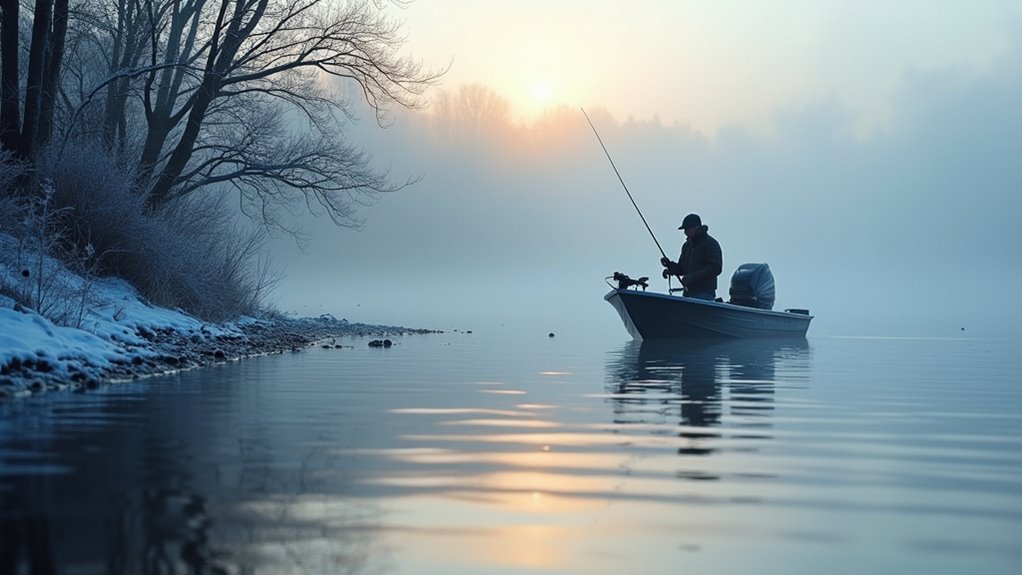
When winter’s icy grip takes hold, bass fishing transforms into an entirely different challenge. We’ve learned that bass don’t vanish—they adapt. In colder months, they migrate 10-20 feet deeper than their summer haunts, becoming noticeably sluggish as their metabolism slows down.
We’ve found these fish still chase the same menu—shad, minnows, and other baitfish—but they eat far less frequently. The upside? They tend to school together in winter, making them predictable once you’ve located them. Trust us, understanding these cold-water patterns is the first step to filling your livewell when the mercury drops.
Selecting the Right Winter Lures and Presentations
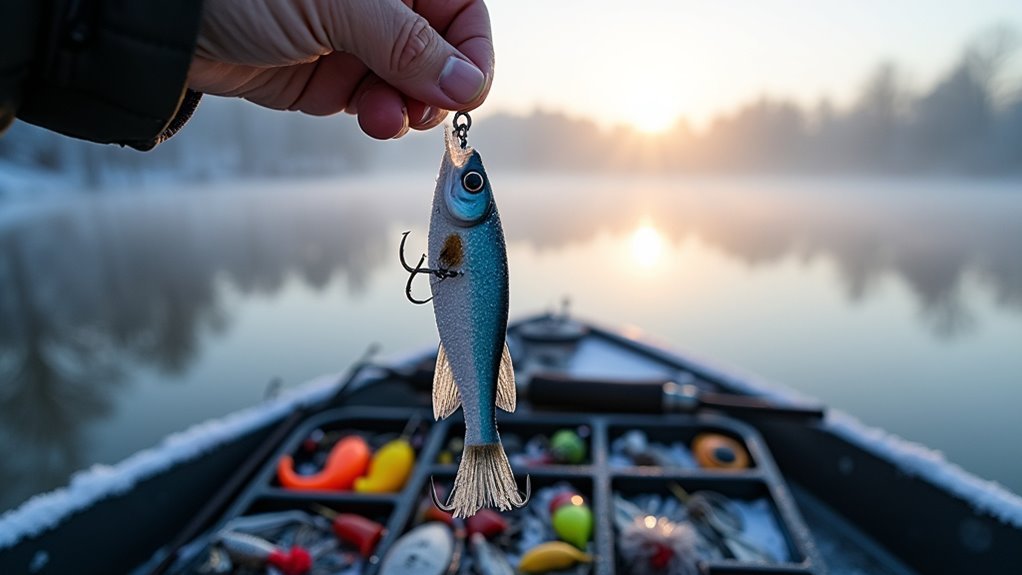
Now that we comprehend how bass behave in winter, let’s focus on what to tie on the end of your line. Cold water means slower presentations and smaller profiles that match sluggish bass metabolism. We’ve found that natural colors work best when the water’s clear as glass.
- Football head jigs with compact trailers
- Silver or white blade baits that mimic dying shad
- Small spoons with a touch of red for attraction
- Finesse plastics on light jig heads
- Suspending jerkbaits worked with long pauses
Slow and Steady: Winter Bass Fishing Techniques That Work
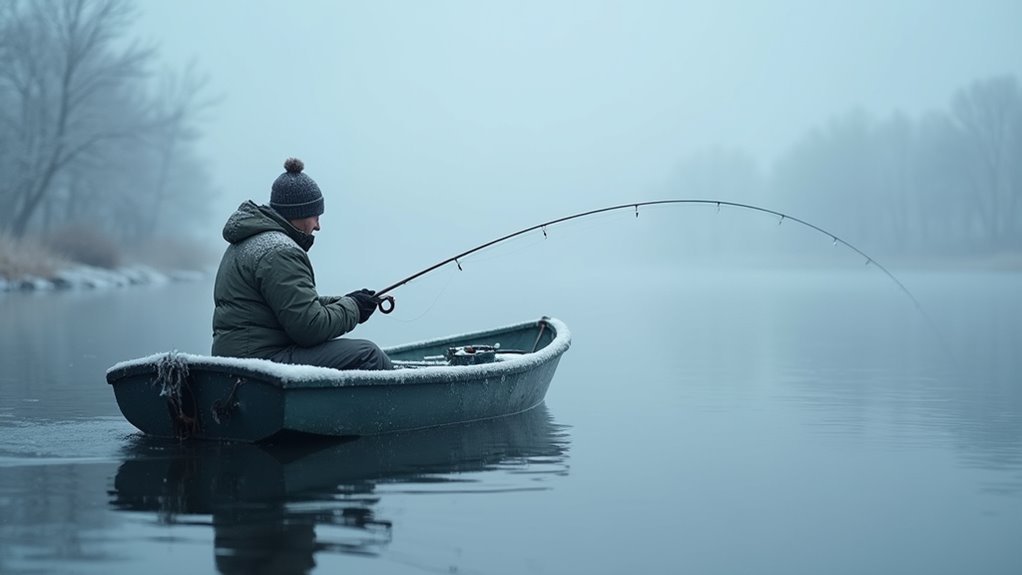
The success of winter bass fishing hinges almost entirely on your willingness to slow down—way down. When water temperatures drop, bass metabolism slows dramatically, making them reluctant to chase fast-moving lures.
We’ve found that painfully slow retrieves often trigger the best strikes. Last January, I was dragging a jig across a deep point so slowly I nearly dozed off—then wham! A 5-pounder hit when the jig paused on a ledge.
Remember to fish vertically in deeper water, and when in doubt, slow down even more. Your patience will be rewarded with those sluggish winter giants.
Finding Bass in Winter: Location Strategies for Cold Water
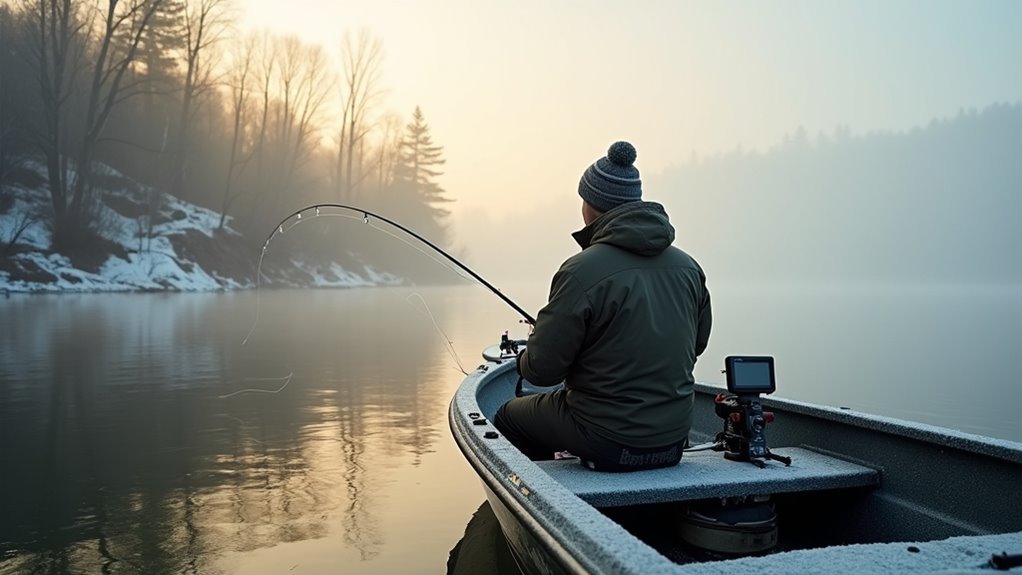
Unlike summer fishing where bass scatter throughout the water column, winter forces these predators to follow predictable patterns that smart anglers can exploit. We’ve found that bass congregate in specific zones when temperatures drop, making your search more focused if you know where to look.
- Deep water adjacent to shallow flats (transition zones)
- Rock piles that retain heat throughout the day
- Points and channel swings near deep water sanctuaries
- Creek channels where baitfish congregate
- Steep banks that receive afternoon sun exposure
The Right Timing: When to Fish for Bass During Winter
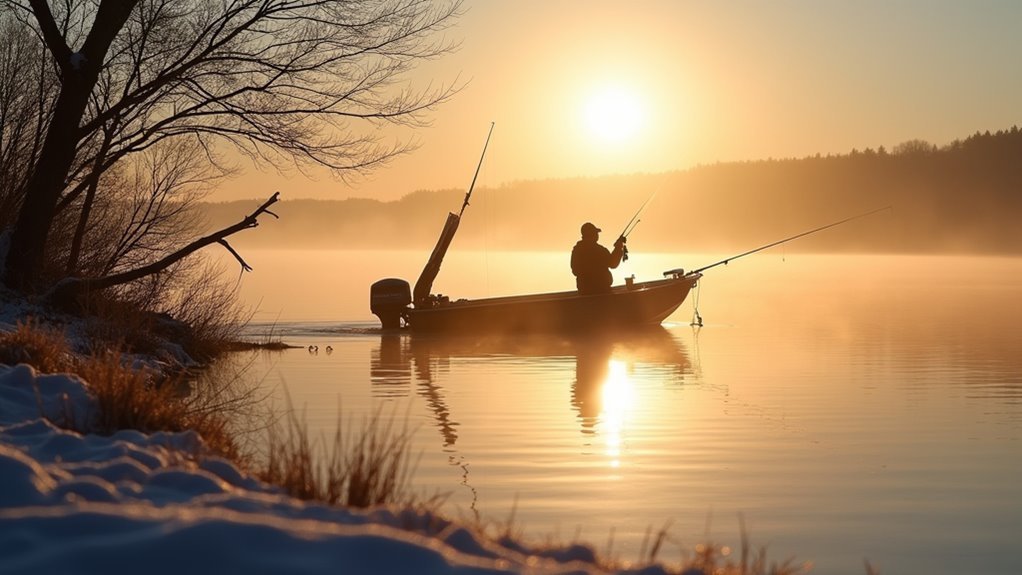
While most anglers pack away their gear during winter months, those who understand the timing secrets of cold-water bass fishing reap rewards others miss. We’ve learned that midday is prime time when winter bass fishing. As the sun climbs, it warms the water slightly, triggering baitfish activity that draws bass to feed.
Unlike summer dawn fishing, we wait until 10 AM to hit the water. I remember catching my biggest winter bass at 2 PM after patiently working a deep ledge. The thermometer read 42 degrees that day—right in that sweet spot when bass maintain regular feeding periods.
Essential Winter Gear and Safety for Bass Anglers
Because cold-weather bass fishing demands more than just technique, we’ve found that proper gear can make the difference between an enjoyable winter outing and a miserable (or dangerous) experience. After nearly losing two fingers to frostbite during a January tournament, I never head out unprepared again.
- Layer clothing strategically – start with moisture-wicking base layers
- Invest in quality waterproof, insulated boots and gloves
- Always bring emergency supplies (first aid kit, hand warmers, extra clothes)
- Tell someone your fishing location and expected return time
- Keep a charged phone in a waterproof container
Frequently Asked Questions
How Does Wind Affect Winter Bass Fishing Success?
Wind can disrupt our success in winter bass fishing by chilling water quickly. We’ll find bass more active with light breezes that oxygenate water, but they’ll hunker down during stronger winds.
Should I Use Scented Baits in Cold Water Conditions?
We recommend using scented baits in cold water. They’re especially effective as bass rely more on smell when sluggish. Even a subtle scent can make your presentation more appealing when their metabolism slows down.
How Do Electronics Enhance Winter Bass Fishing?
In the unfathomably complex winter world, electronics are our lifesavers. We’ll find bass easier with fish finders showing depth, structure and temperature. They’ll help us locate schools when they’re concentrated in specific areas.
Can I Catch Bass Through Ice in Frozen Lakes?
Yes, we can catch bass through ice! We’ll need specific ice fishing gear and techniques. Target deeper sections near structure where bass school up during winter’s coldest periods.
Does Moon Phase Impact Winter Bass Feeding Patterns?
Like clockwork, moon phases do influence winter bass feeding. We’ve found bass often become more active during full and new moons, even in winter’s grip, though temperature remains the primary driver.
Conclusion
While most anglers hang up their rods when winter arrives, we’re out there landing monster bass! Ironically, the lakes that seem most lifeless this time of year often hold the biggest opportunities. We’ve learned through countless frigid mornings that patience and adaptation are your best tools. So while everyone else waits for spring, we’ll be quietly mastering the cold water patterns that turn winter’s challenges into our secret advantage.